|
Accounting | Business | Computer Science | General Studies | Math | Sciences | Civics Exam | Help/Support | Join/Cancel | Contact Us | Login/Log Out Homework Chapter
1A 1B 2A 2B 3A 3B 4A 4B 5A 6A Chapter Tests 1 2 3 4 5 6 7 FINAL EXAM Need A Tutor? Need Homework Help?
Calculus For Business Homework Chapter 3 Part B f(x) = 

The quotient rule states that Now let’s establish some of the rules. f = the numerator g = the denominator f’ is F prime (which is the derivative of f) g’ is G prime (which is the derivative of g) In this case f = 3x + 5 and f’ (f prime or derivative) = 3 g = 9x + 8 and g’ (g prime or derivative) = 9 So, we can start to plug the values in, factor, and solve! So far, we have f = 3x + 5 g = 9x + 8 f’ = 3 g’ = 9 we can now plug the values into 
Now we can simplify. *We do not need to simplify the bottom. 9x + 5(3) = (27x + 24) – 3x - 5(9) = (-27x - 45) (since we are subtracting , both values will need to be negative) So, we are left with 27x – 27x + 24 – 45 (we will group by common terms) 27x – 27x + 24 – 45 27x – 27x = 0 24 – 45 = -21 Now we can put the equation back together (remember we did not need to factor or simplify the denominator (9x + 8)2 The answer is Find the derivative of the function. y = 
We would do the same as above. You will have to solve quite a few of these, so focus and practice. One thing you need to remember is the values of fg’ will need to be negative! The quotient rule states that  ] = ] = Now let’s establish some of the rules. f = the numerator g = the denominator f’ is F prime (which is the derivative of f) g’ is G prime (which is the derivative of g) In this case f = 8x - 1 g = 3x + 7 f’ = 8 (the derivative of f) g’ = 3 (the derivative of g) Now we can plug the values into y = 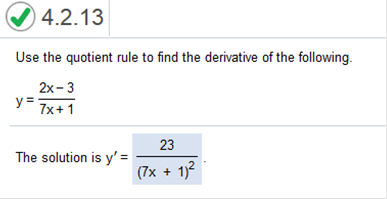
This is the same procedure as above. 
f = 2x - 3 g = 7x + 1 f’ = 2 (the derivative of f) g’ = 7 (the derivative of g) The answer is 
Ti-nspire 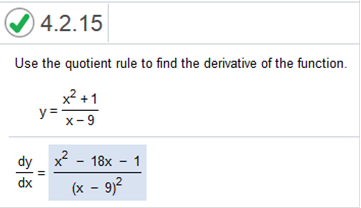
This is the same procedure as above; however, the expressions are a little different, So, I will list the steps to solve it for you. It will be best if you list the values like do below. 
f = x2 + 1 g = x - 9 f’ = 2x (the derivative of f) g’ = 1 (the derivative of g) We know what g2 is. it is (x – 9)2 Use the quotient rule to find the derivative of the following. 
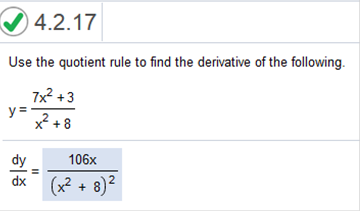

f = 7x2 + 3 g = x2 + 8 f’ = 14x (the derivative of f) g’ = 2x (the derivative of g) We know what g2 is. it is (x2 + 8)2 Use the quotient rule to find the derivative of the following. 
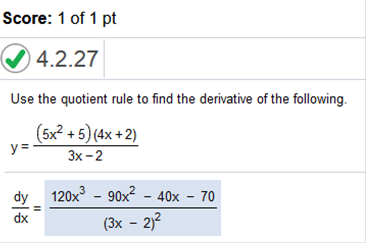
First we need to factor and simplify f (the numerator) 
5x2(4x) = 20x3 5x2(2) = 10x2 5(4x) = 20x 5(2) = 10 So, we have f = 20x3 + 10x2 + 20x – 10. We can rewrite the equation now. f = g = 3x - 2 f’ = 60x2 + 20x + 20 (the derivative of f) g’ = 3 (the derivative of g) We know what g2 is. it is (x2 + 8)2 
The total cost (in hundreds of dollars) to produce x units of a product is c(x) = Find the average cost for each of the following production levels. a. 20 units b. x units c. Find the marginal cost 
a. 15.22 b. . c. a. 7(20) – 3/2(20) + 5 = 137 / 45 = menu | number | convert to decimal = 3.04444(100) / 20 = 15.2222 (round to 15.22) b. A psychologist contends that the number of facts of a certain type that are remembered after t hours is given by the following function. 
We use the quotient rule to differentiate the function. Then we plug the values in to solve it. We use the same procedure as we have been using. f = 92t g = 99t – 92 f’ = 92 g’ = 99 so, we know g2 = ( 99t(92) = 9108t -92(92) = -8464 So we are left with 9108t – 9108t – 8464 which = -8,464 (there is no need to plug in any values) Now we plug in the value 1 into g2 [ So we are left with -8464 / 49 -8464 / 49 = -172.734 (-173) Plug in 10 round to the nearest integer which equals 0 Write the function as a composition of two functions. y = (1 – x2)3/8 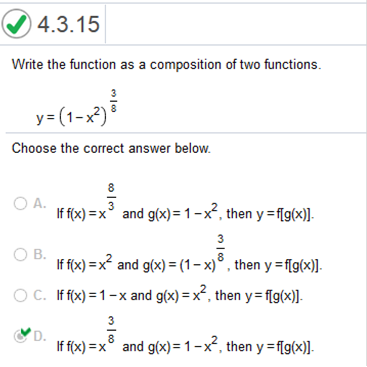
Write the function as a composition of two functions. y = -√14 + 4x 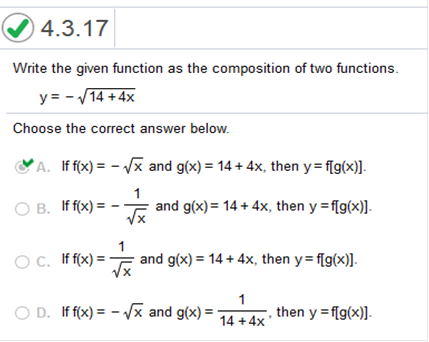
Find the derivative of the function y = (9x4 – 3x2 + 7)4 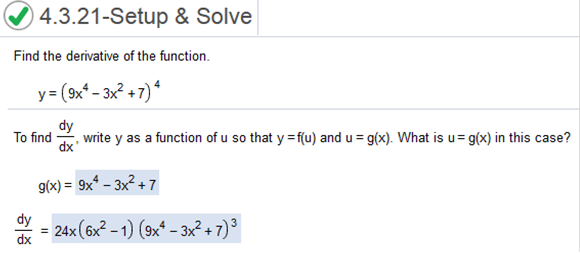
Explanation First, we multiply 4 (9x4 – 3x2 + 7)4 – 1 = 4 (9x4 – 3x2 + 7)3 Next, we find the derivative of 9x4 – 3x2 + 7 = 36x3 – 6x Now we set up the equation and simplify 4(36x3 – 6x) (9x4 – 3x2 + 7)3 Now we simplify the left side. 24x (6x2 – 1) (9x4 – 3x2 + 7)3 Check https://www.derivative-calculator.net/ (9x^4-3x^2+7)^4 Find the derivative of the function y = (5x4 – 7x2 + 8)4 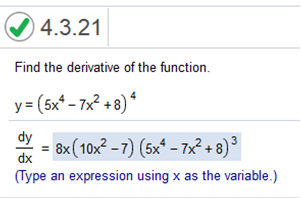
Explanation: Same steps as above 4(5x4 – 7x2 + 8)4 – 1 = 4(5x4 – 7x2 + 8)3 Find the derivative of 5x4 – 7x2 + 8 = 20x3 – 14x Now we set up the equation and simplify 4(20x3 – 14x) (5x4 – 7x2 + 8)3 We simplify this à 4(20x3 – 14x) take a close look at the answer. We will subtract 1 from the exponent, multiply 4(2x) and divide -14 / 2 The answer is 8x (10x2 – 14x) (5x4 – 7x2 + 8)3 y = -6 (3x2 + 8)-6 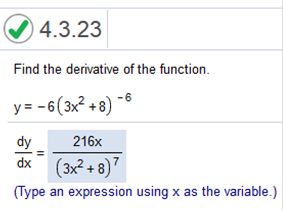 First, we can see that the answer will be a fraction, so we need to look at the denominator (bottom) first. The denominator will always be this part -> (3x2 + 8)-6, however, we will need to subtract 1 from the exponent. So, the denominator will be (3x2 + 8)-6 – 1 which equals (3x2 + 8)-7 And remember, it will be positive, because we are moving it to the bottom of the fraction. We have the denominator which is (3x2 + 8)7 The numerator is rather simple; however, you really need to focus on what I am doing here. You will see that I use the same principle below. The numerator will be -6 · -6 because we are multiplying the -6 exponent by the first part of the equation. So now we have -6 · -6 = 36 Now we take the derivative of 3x2 which is 2 · 3x which equals 6 x So, we have 36 · 6x which equals 216x. The numerator = 216x the denominator = (3x2 + 8)7 Problem solved. Now we put the answer together. Find the derivative of the function s(t) = 42(2t3 – 9)6/5 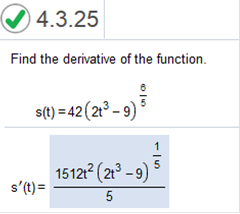 We do the same with this, however, we have an exponent which is a fraction, and in the case, we use the numerator of the fraction. This is a bit different in that we will not move the whole exponent to the bottom, because the exponent will be a fraction. We can use the same trick though. We subtract 1 from the outer exponent first. 6/5 – 1 = 6/5 – 5/5 = 1/5. Since we are subtraction, we must move 5 to the bottom. You may ask why? That’s because we are dividing 6/5 – 5/5. We need to leave 5 at the bottom. So, we have the denominator. Which = 5 Now for the numerator. We only use the 6 from 6/5, and we already have the outer exponent, which = 1/5 We simply factor like so, 6(42) times the derivative of 2t3 Let’s find the derivative of 2t3 first which = 6t2 So, we have 6 · 42 · 6t2 = 1512t2 Please study my answer carefully. Find the derivative f(x) = 4√3x2 + 5 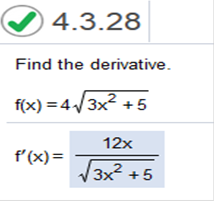
This is simply 4(3x) divided by √3x2 + 5 = Simplified it would be Find the derivative 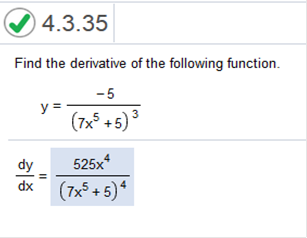
We can use a shortcut with this one also. We find the derivative of 7x5 + 5 which = 35x4 We need to use the outer exponent on the bottom (denominator), however we will be moving it up, so it will be negative And we will be subtracting 1 the same as we have been doing. We will be moving it down again, so keep that in mind. So, we have 35x4 · (-5 · -3) = 35x4(15) = 525x4 (we used the -5 on top, the negative outer exponent from the bottom, and the derivative of 7x5 + 5) We have the numerator which = 525x4. The denominator is the same as the equation we were asked to solve however, we needed to subtract 1 from the outer exponent after we moved it up, The exponent was then -3 then we subtracted 1 and ended up with -4. We needed to move it back down, so it is 4 So the answer is: 
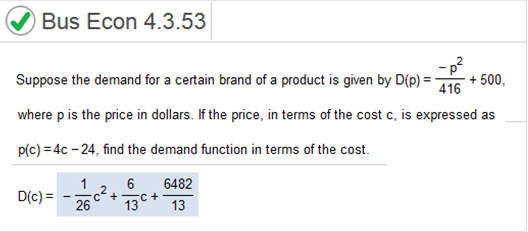
Suppose the demand for a certain brand of a product is given by D(p) where p is the price in dollars. If the price, in terms of the cost c, is expressed as find the demand function in terms of the cost. Rewrite equation -(4c – 24)2 / 416 + 500 To test an individual's use of a certain mineral, a researcher injects a small amount of a radioactive form of that mineral into the person's bloodstream. The mineral remaining in the bloodstream is measured each day for several days. Suppose the amount of the mineral remaining in the bloodstream (in milligrams per cubic centimeter) t days after the initial injection is approximated by -0.01 
Find the derivative of ½(8t + 4)-1/2 Then plug in the value of 4 (days) Find the derivative of the function. y = e10x What rule should be used to differentiate? 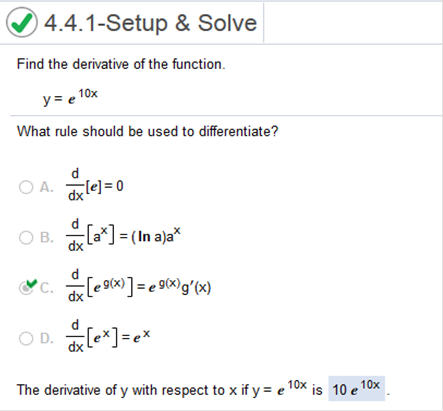
The first part gives you the formula for finding derivatives with exponents and variables (x, t, etc…) The second part. Since the value of x is present as an exponent, we would use 10 to find the derivative and leave the rest the same. So, it is 10(e10x) = 10e10x Differentiate the following function. F(x) = 5e5x 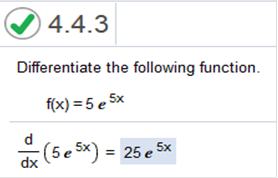
This is explained above. Since the value of x is present as an exponent, we would use 5 to find the derivative. So, we multiply 5(5) which = 25 and leave the rest alone. The answer = 25e5x Find the derivative of the function. f(x) = -5e-2x + 2 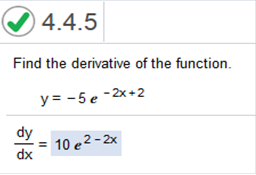
This is the same as above. Since the value of x is present as an exponent, we would use -2 to find the derivative. So, we would multiply -2(-5) which = 10 and leave the rest alone. The answer has some values swapped, but it is the same. The answer is 10e2 – 2x Differentiate the following function. y = ex4 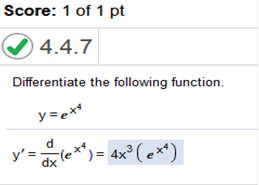
We simply find the derivative of x4 and multiply it by ex4 The derivative of x4 = 4x3 Now we multiply by ex4 4x3(ex4) Find the derivative of the function. y = 2e-3x2 find derivative ti-npire 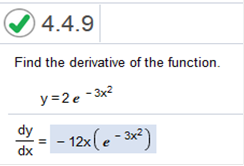
Find the derivative of the following function. y = 105x + 1 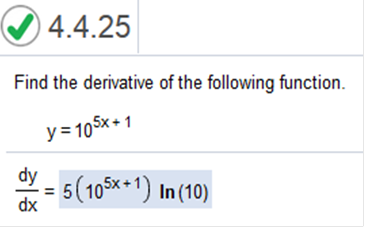
Differentiate using the chain rule, which states that ln (10) · 105x+1 · ln (10) · 105x+1 · Now simplify 5(105x + 1) ln(10) The sales of a new high-tech item (in thousands) are given by S(t) = 97 – 80e-0.2t Find the derivative and plug in the year values 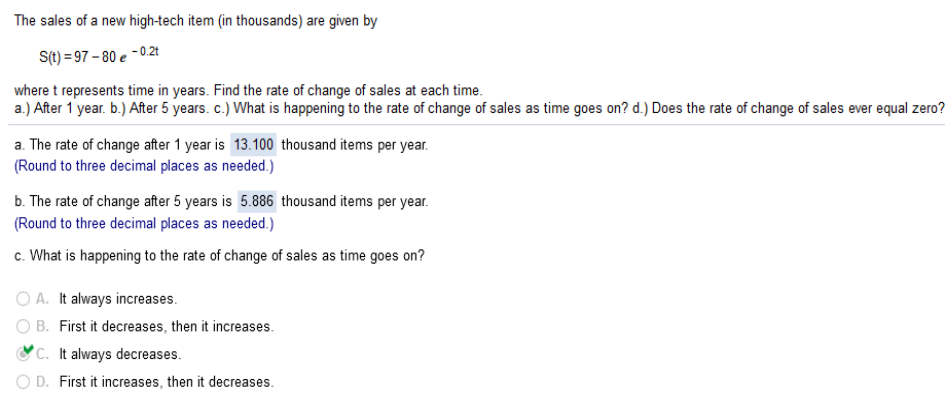 
Part a. We need to find the derivative of 97 – 80e-0.2t and plug in the value (1 year). What we do here is simple. We multiply -0.2(80e) which = 16e. We leave the rest alone, so the derivative of 97 – 80e-0.2t = 16e-0.2t Now we plug in the value. 16e-0.2(1) (you will need a calculator for e) The answer is 13.09969205 (round to 13.100) Part b. We simply plug in the value 5 like so 16e-0.2(5) use a calculator. The answer is 5.886071059 (round to 5.886) Part c. If you haven’t noticed, the rate of changed decreased from 1 year to 5 years. Part d. Common sense here. The projected population of a certain ethnic group (in millions) can be approximated by p(t) = 35.54(1.024)t where t = 0 corresponds to 2000 and 0 ≤ t ≤ 50 
Explanation: you can use a TI84 Plus calculator and enter exactly what I have. a. 35.54 (1.024)10 b. 35.54ln(1.024)1.02410 Differentiate f(x) = ln(10x) 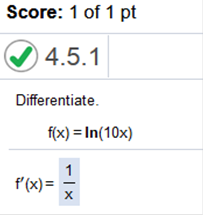
The easiest way to do this is to find the derivative of 10x, which = 10 Then we must divide by 10 + x (not 10x because ln cancels it out). So, we are left with Now we divide 10 by 10 which = 1 Differentiate y = ln|4x2 – 5x| find the derivative of 4x2 – 11x then divide by 4x2 – 11x 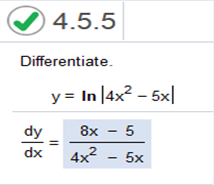
The derivative of ln(u) = u’ is u prime or the derivative of u. u’ = 8x – 5 u = 4x2 - 5x the answer is A friend concludes that because y equals ln 6x and y = ln x have the same derivative, namely dy/dx = 1/x, these two functions must be the same. Explain why this is incorrect. Choose the correct answer below. A. A derivative shows the function at a certain point. Even though the function y equals ln 6 xy = ln6x and y equals ln xy = lnx have the same derivative, the derivative only shows that the functions are the same at a certain point. B. A derivative is a measure of how a function changes as its input changes. It is incorrect because the derivative shows how the functions change at an equal rate, not that the functions are the same. C. A derivative shows the function's y-intercepts. Even though the function y equals ln 6 xy=ln6x and y equals ln xy=lnx have the same derivative, the derivative only shows that the functions have the same y-intercepts. 
This is self-explanatory! If total revenue received from the sale of x items is given by R(x) = 30 ln (2x+1), while the total cost to produce x items is C(x) = (a) The marginal revenue (b) The profit function P(x) (c) The marginal profit when x = 60 (d) Interpret the results of part (c). 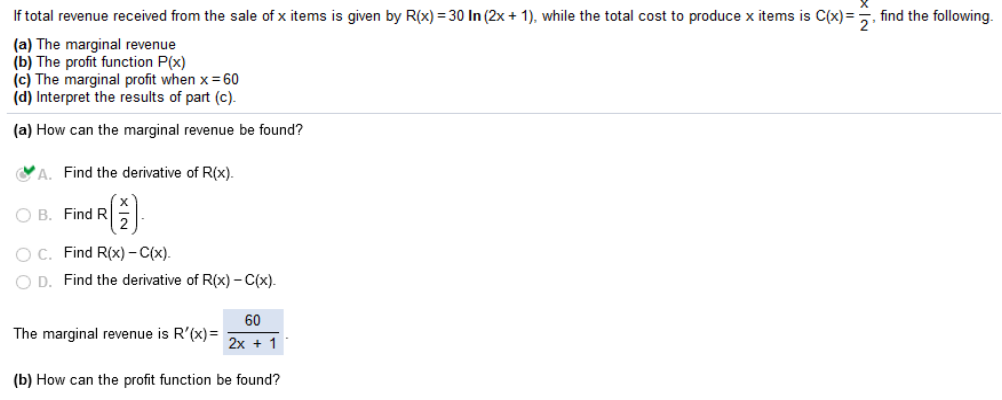 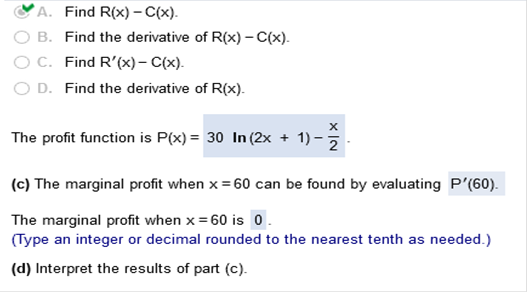 
The answers are self-explanatory Find the indicated derivative f(u) = 3u0.8 – 2u2.2 
We can break this down and find the derivative very easily. 3u0.8 – 2u2.2 .08(3u).08 – 1 = 2.4u-0.2 2.2(-2)2.2 – 1 = -4.41.2 We need to convert 2.4u-0.2 to fraction form because the exponent is negative 2.4u-0.2 = Now we can put the equation back together in proper order. -4.41.2 + Find the derivative of the function. 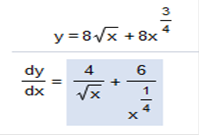
First, we would need to covert 8√x to a fraction. The fraction form of 8√x = 8x1/2 so now we can rewrite the equation We need to find the derivative of 8x1/2 + 8x3/4 so this is how we do that. Now we need to convert back to a fraction because the exponents are negative. Remember, the square root of x is x1/2. We have x-1/2, so we can rewrite that as The answer is Find the derivative of the function 15x2 – 3x – 9x-2 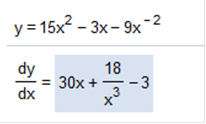
15x2 – 3x – 9x-2 15(2)2 – 1 = 30x -3x(1)1 – 1 = -3 -9x(-2)-2 – 1 = 18-3 = 18/x3 (We will need to convert this to fraction form) Find the derivative of the function. y = 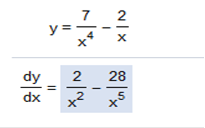
The process for this problem is long, and quite frankly, prone for mistakes. SO, I have a shortcut once again to cut the time down considerably. You can solve this problem one of two ways. You can move the variables and exponents up or we can leave the exponents on the bottom and add. This is the similar shortcut that I use on the other problems. I will solve it by moving the exponents up. Let’s start with We do not need to use a negative except for the exponent, because we will move the variable and exponent back down. So, this is all we need to do 7x-4 – 1, find the derivative of 7x4 and we get 7x-5, 28x. We are moving the variables and exponents back down, so we have We do the same with We are moving the variables and exponents back down, so we have We can swap the expressions, so the answer = Find the derivative of the function. 
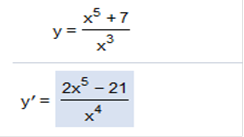
This is a difficult problem to solve, however, I will try and simplify it as much as possible. Try and focus on it very carefully. 
g(x) = x3 f(x) = x5 + 7 f’(x) = the derivative of x5 + 7 which = 5x4 f’ g(x) = the derivative of x3 which = 3x2 so, we have 
Staring from top left, we multiply x3(x4) = x7 and separate 5 and move to the left. We can combine 5(x7), and multiply x2(3) = x6) 
Next, we can move 3 (from 3x2) to the left following the minus sign 
Next, we can factor x2 out of x7 on top (we do this to create a common term on top and bottom) 
Now we can cancel some common factors (x2, and x6) Watch closely at the remaining equation! Now we can simplify. Let’s factor the right side before doing so. (subtract 5x5 – 3x5 = 2x5) The answer = Find the derivative of the function. 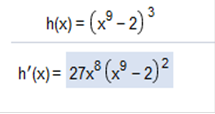
This is the formula that we have been working on above, However, we can use the same shortcut with this as we have above. Shortcut We find the derivative of x9 – 2 which is 9x8 The exponent on the right side of the exponent is 3, so we can do this in one equation. Focus on what I have done below. (x9 – 2) stays the same, 3 is multiplied by 9x8, and we need to subtract 1 from the outer exponent. 3(9x8) + (x9 – 2)3 – 2 = 27x8(x9 – 2)2 Homework Chapter
1A 1B 2A 2B 3A 3B 4A 4B 5A 6A Chapter Tests 1 2 3 4 5 6 7 FINAL EXAM Need A Tutor? Need Homework Help?
|
| Home |
Accounting & Finance | Business |
Computer Science | General Studies | Math | Sciences |
Civics Exam |
Everything
Else |
Help & Support |
Join/Cancel |
Contact Us |
Login / Log Out |